How to Cut a Beef Tenderloin
This perfect Reverse Sear Beef Tenderloin is just the thing you want to make (and eat!) for the most special of occasions and holidays. It will certainly impress with lots of "wow" factor, but with very little stress or mess to deal with!
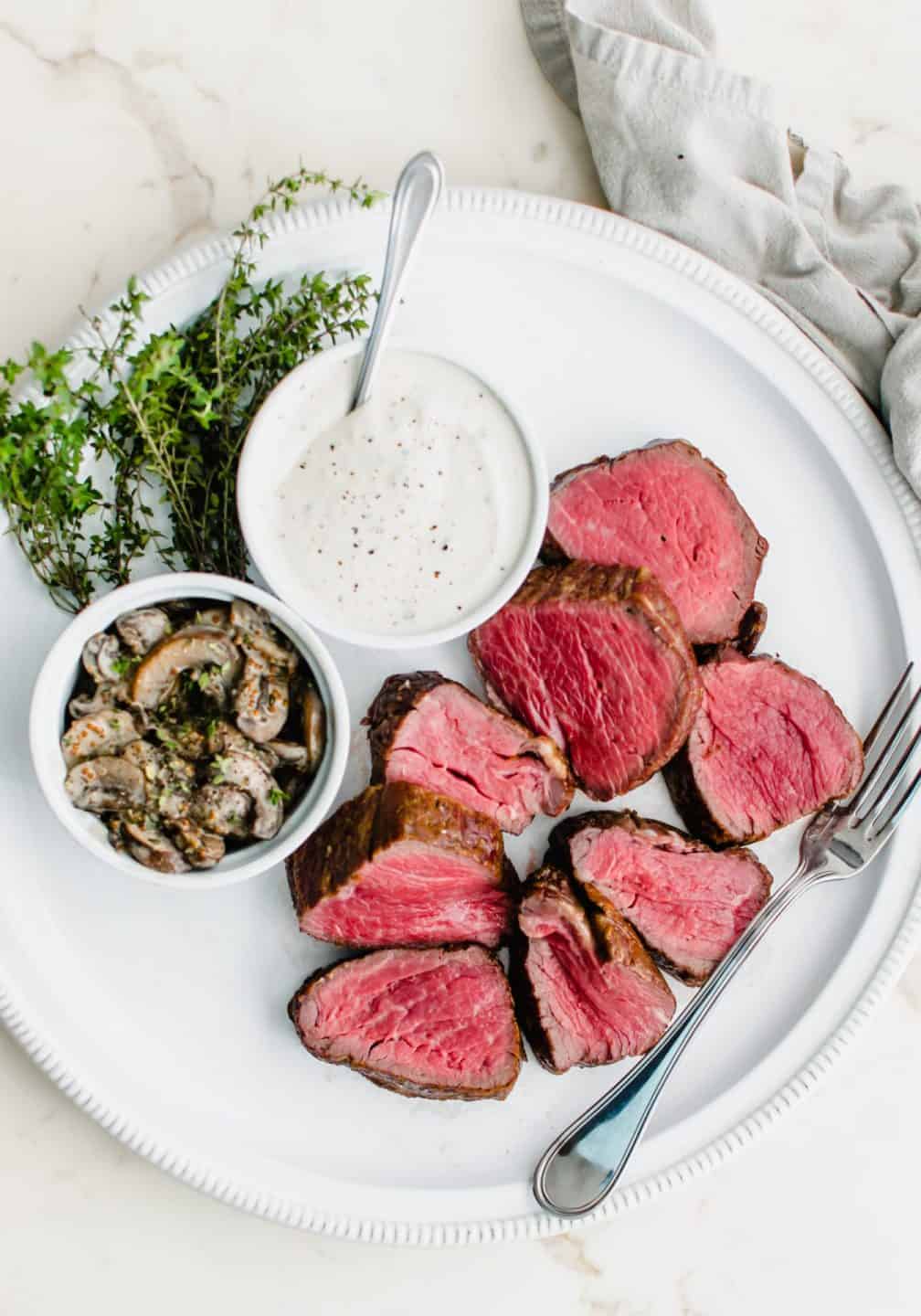
Jump to:
- Video
- Ingredients
- Instructions
- Top tips
- Similar recipes
- Recipe
- Comments
Beef tenderloin has to be my favorite holiday and special occasion dish. It's always so tender, flavorful, juicy, and just feels fancy, you know? For the longest time, I was intimidated to cook it at home. It's a spendy cut of meat, and any cooking result that was less than perfect made me feel like I had wasted my money. And the stress that came along with trying to make it come out perfect took a bit of the joy out of eating it!
Video
Up until the past year, I would cook beef tenderloin by searing it in a hot skillet and then finishing it by roasting at a high temperature - like 425 - in the oven. That's a great way to do it, but it takes a little more minding and guesswork that I'd prefer to avoid when I'm getting ready to serve a nice dinner. I've also tried the sous vide method, which involves cooking the meat sealed in a hot water bath and then searing it.
This definitely works and is much easier to control, but I could never get the nice golden-brown crust that I love on beef. But now I'm sold and will be a forever fan of the reverse-sear method, thanks to Alton Brown's Reloaded episode of Good Eats on steak. He uses this tried and true process and technique to cook a ribeye that looked so stellar I couldn't help but try it on beef tenderloin. Read on to learn more!
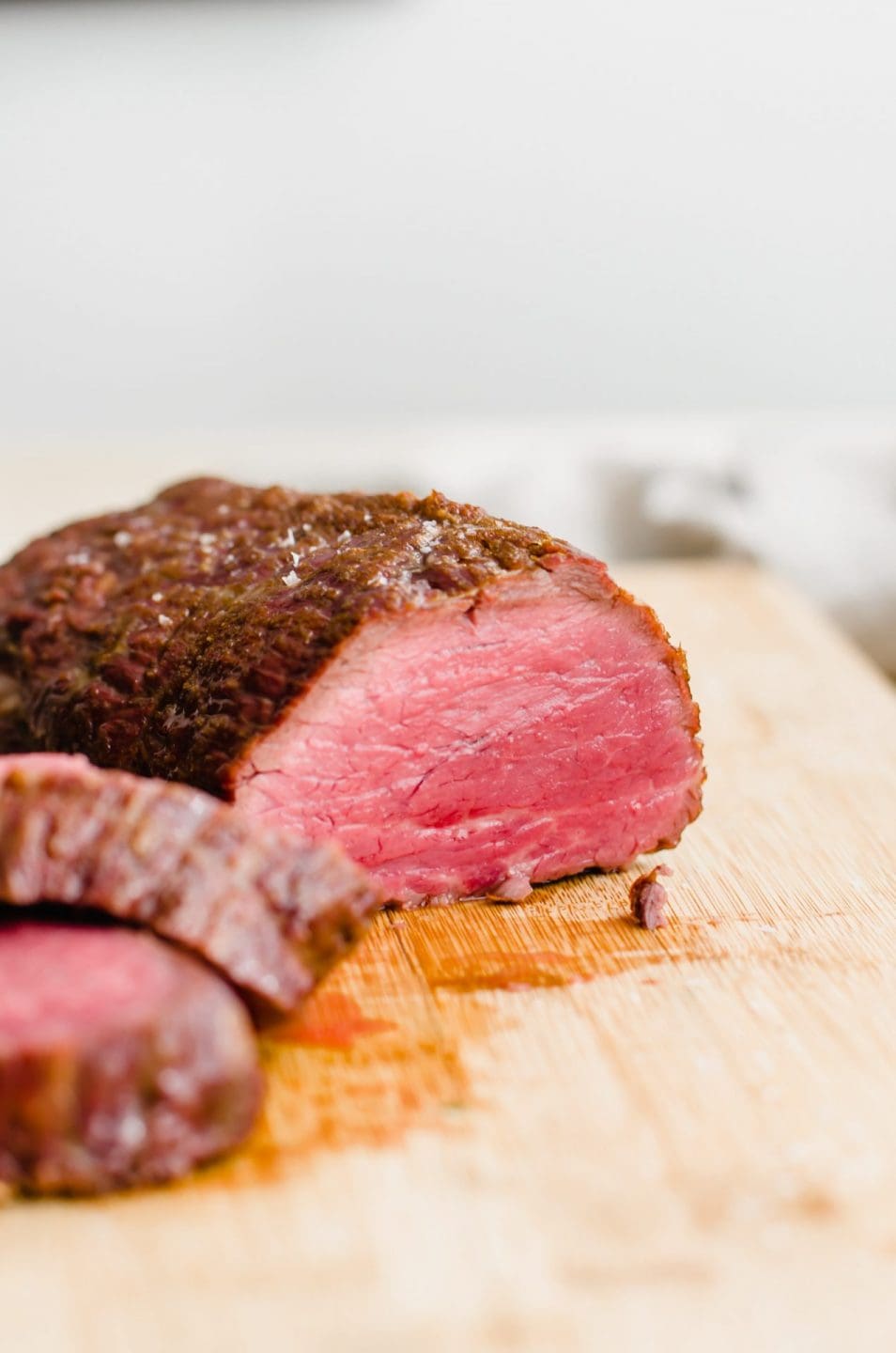
Ingredients
- One 2-pound USDA Choice beef tenderloin (see more on grading in the Tips section below) - this should feed 4 very hungry people as the main entree or 6 moderately hungry people. You can stretch it to 8 servings if you plan to serve something like a lobster tail on the side.
- Coarse kosher salt - this is the most essential ingredient for seasoning the meat and helping it develop a nice crust on the exterior.
- High-heat cooking oil - something with a high smoke point, like peanut, canola, or vegetable oil is best for the searing part of the recipe.
- Butter - I like to rub some butter on the outside of the whole tenderloin right after it has seared and needs to rest before slicing. This creates a glistening shine on the exterior of the crust and makes the meat look sumptuous and mouthwatering.
- Sauce - you don't really need it, as the tenderloin is perfection on its own. But if you have to have it, I've got simple recipes for a horseradish cream and drunken mushrooms included below. I'd recommend serving accouterments on the side and letting guests help themselves - you really want to let the meat shine here!
- Equipment - a wire rack for curing and cooking the tenderloin on, a digital thermometer with an oven-safe probe, kitchen twine, tongs for flipping the meat while searing, and a good cast-iron skillet are absolutely necessary for making this dish come out just right!
Ingredient amounts/instructions listed in the recipe below.
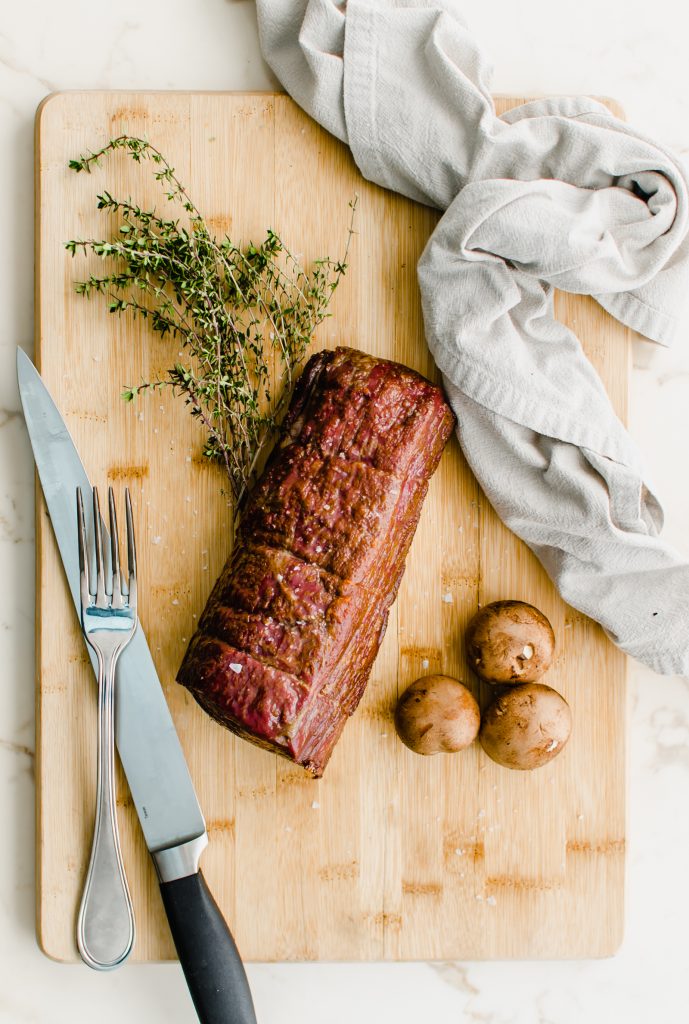
Instructions
- Tie your tenderloin - sometimes beef tenderloins have a thinner "tail" side that you will want to tuck in and tie to the thicker portion of the tenderloin. Use kitchen twine to tie the tenderloin every 2-3 inches so it has an even thickness throughout the length of the cut of beef. This will help it cook evenly.
- Place the tenderloin on a wire rack set inside of a baking dish - a wire rack is essential for allowing air to circulate under the tenderloin as it ages in the fridge and as it cooks in the oven.
- Salt the tenderloin - about a tablespoon of coarse Kosher salt will be used to coat the entire tenderloin - all sides and ends included. Use clean hands to press the salt into the meat as you season it.
- Let it cure in the refrigerator for 8-24 hours - place the tenderloin, uncovered, in the refrigerator and let it rest until you are ready to cook it. This brings some of the juices to the exterior of the meat, which ends up drying on the exterior and creates an amazing crust once seared. It also gives the salt time to penetrate through the muscle, making it flavorful throughout the entire tenderloin. Since it is open-air raw meat, be sure to place it in the lowest portion of your refrigerator in a place where it will not come in contact with other foods.
- Slow roast the tenderloin - transfer the wire rack to a baking sheet and insert a digital thermometer probe into the center of the tenderloin on one end (see picture). You will roast the meat until it reaches an internal temperature of 120 degrees F for a steak that is medium-rare once completely finished.
- Rest, then sear - rest the meat for 10 minutes. While it is resting, place a cast-iron skillet over medium-high heat until it has a surface temperature of 600 degrees F. You'll know it's ready when a drop of water on the surface completely evaporates in 5 seconds. Coat the bottom of the pan with oil, then sear the tenderloin for 45-seconds on each on each of the 4 sides and 30-seconds on the ends.
- Rest again 10 minutes , then slice and serve!
Complete instructions are found in the recipe below.
This is a picture of the tenderloin once tied and placed on the wire rack:
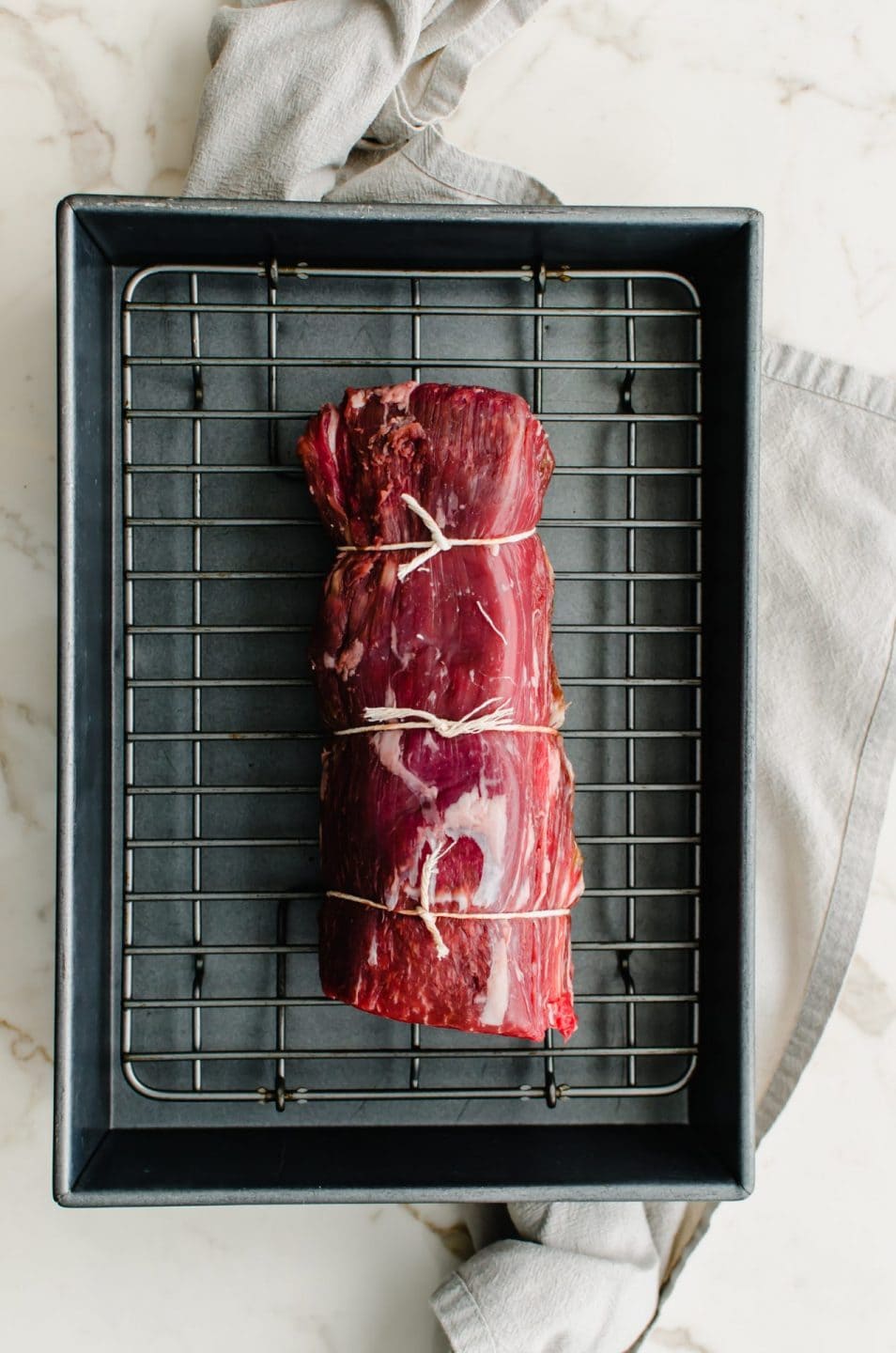
After salting the tenderloin:
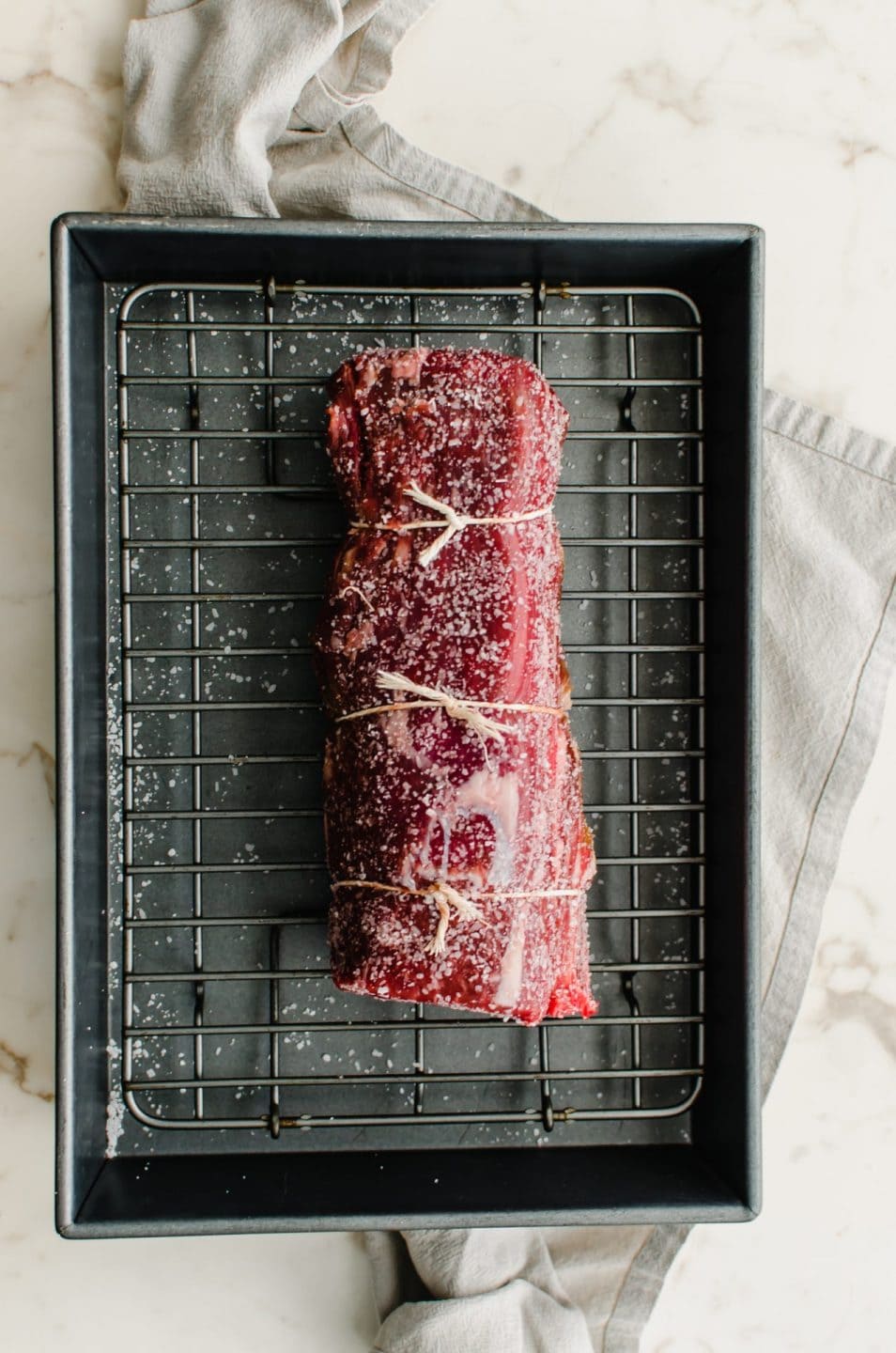
This is a picture of the tenderloin after it has roasted, during the resting time right before searing. Note how the thermometer is still in the tenderloin - do not remove it until the meat has rested a bit to avoid juices leaking out.
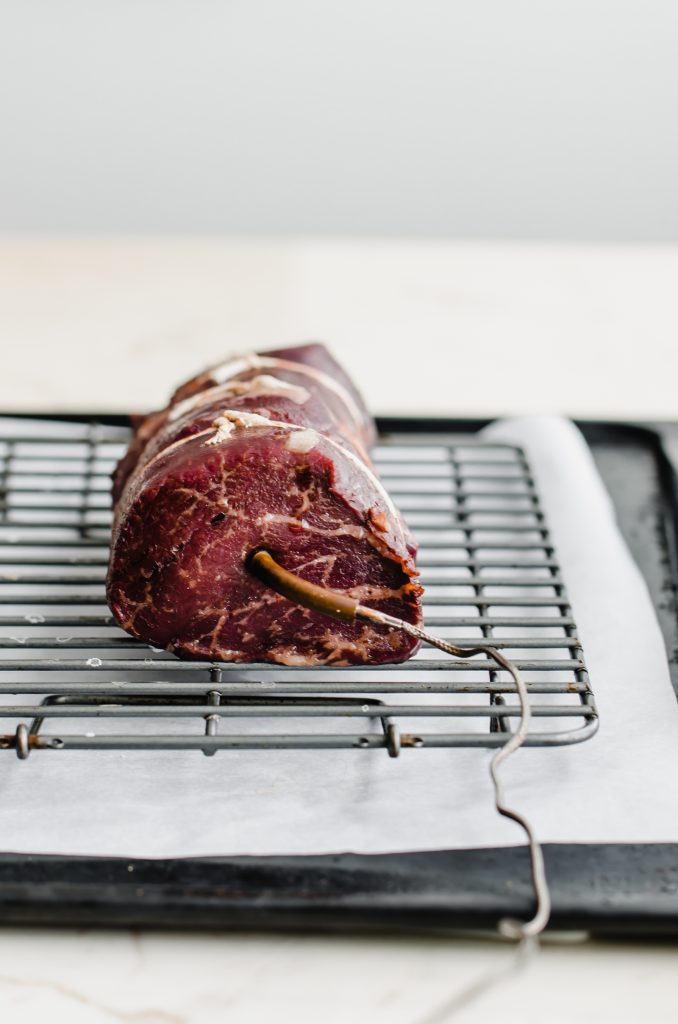
The beef in the photo above has been roasted. In the photo below, the beef has been seared and coated with a little butter to make it glisten.
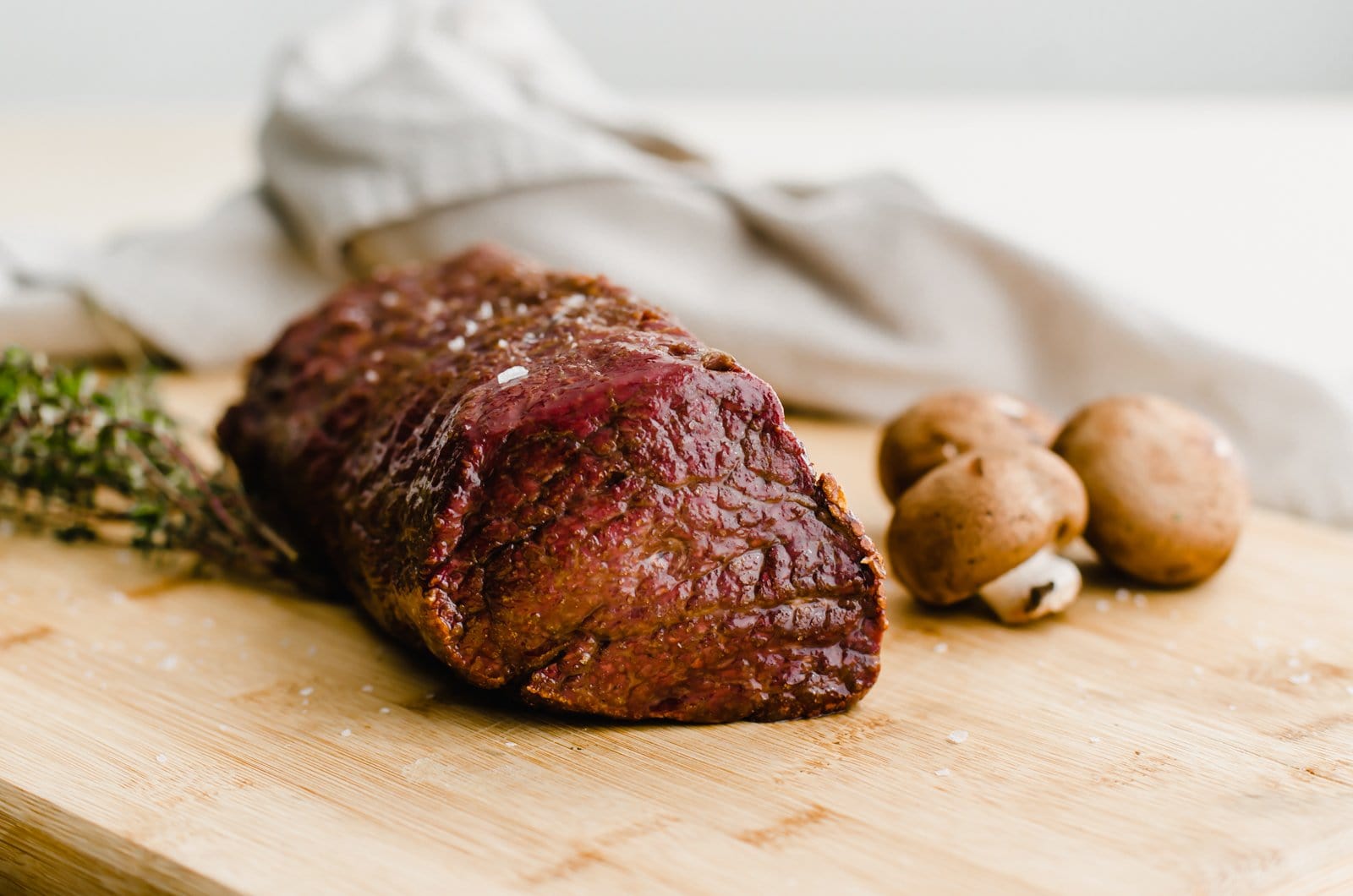
The photo below shows what the interior of the tenderloin looks like when sliced. It is cooked to a perfect medium-rare, and the rosy pink color is evenly distributed throughout the entire tenderloin with an even layer of crust on the outside. This is what you want!
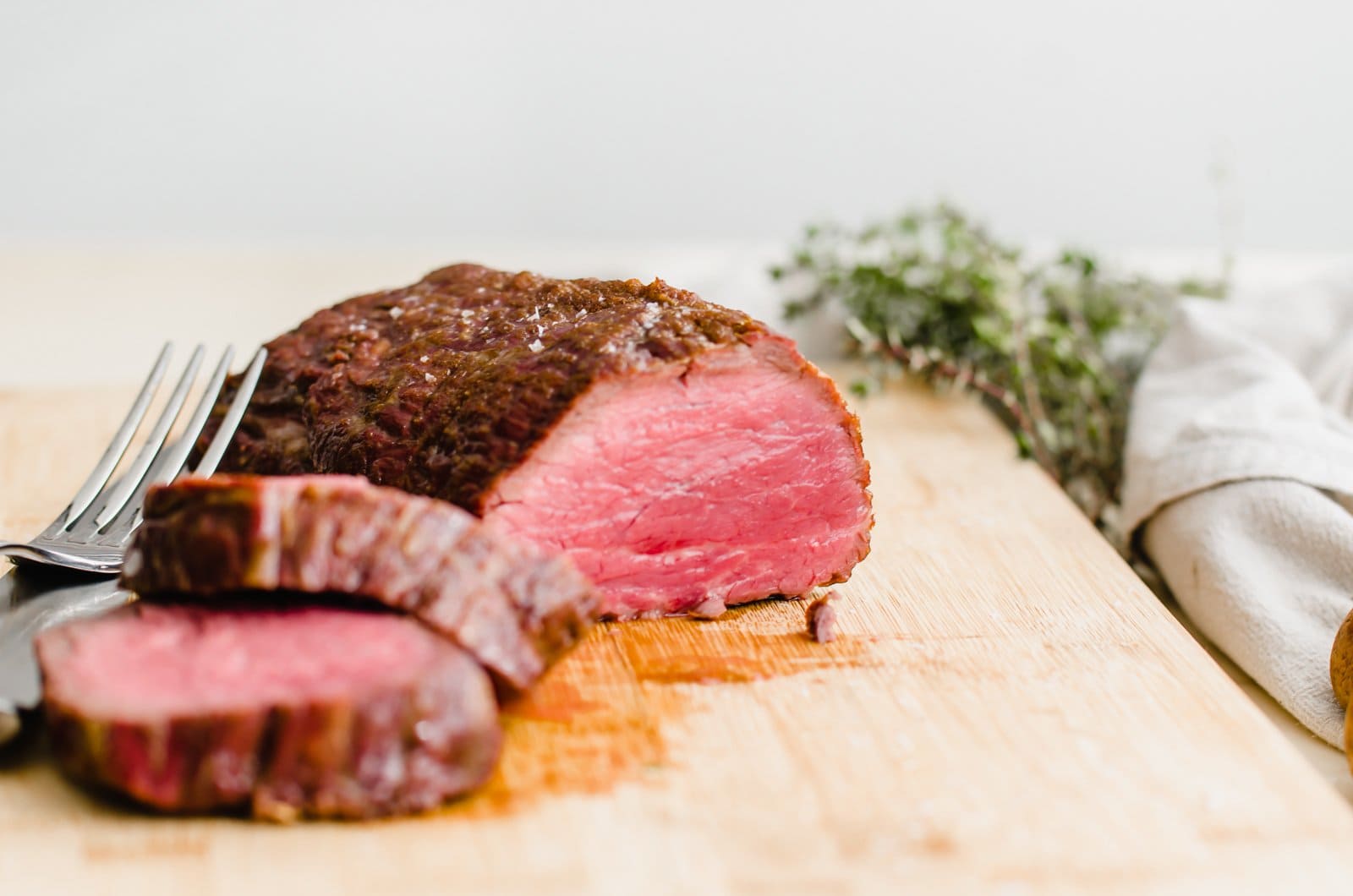
Top tips
- Save your money and don't buy prime beef . I know, that sounds like I'm giving you bad advice. But here's the thing, beef tenderloin is a very lean cut of meat - one of the leanest cuts you can buy. Because of where it is located in a cow, it's extremely tender and flavorful while also being lean. Beef is graded based on the amount and distribution of fat marbling throughout the cut, as well as the age of the cow. It's better to splurge on prime beef when you are purchasing a cut that naturally has more fat and will benefit from even marbling, like ribeye, flat iron, or prime rib roast. The USDA Choice grade for beef tenderloin is just right for a rich and delicious dining experience!
- Time for making sides : the total cooking time for the beef tenderloin, once it has cured in the fridge, is about 2 hours. This gives you plenty of time to set the table, pour a drink, and make a few simple and delicious sides to go along with the beef. You can also make a sauce or two for the tenderloin (recipes provided at the bottom of the post). Might I recommend:
- Perfect Roasted Asparagus
- Crispy Roasted Brussels Sprouts with Parmesan and Honey Glaze (roast while the tenderloin rests and sears)
- Parmesan Herb Duchess Potatoes
- Lemon Risotto
- Butternut Squash Risotto
- Reheating beef tenderloin - why would you need to do this? Because it will all be gobbled up, right??? But sometimes, you have leftovers. And that's ok. The best way to reheat sliced tenderloin is with a sous vide machine. Set it to 120 degrees F, and reheat the meat in a sealed bag for 45 minutes to one hour. Once heated through, remove and sear for 30 seconds on each side in a very hot cast-iron skillet, then serve.
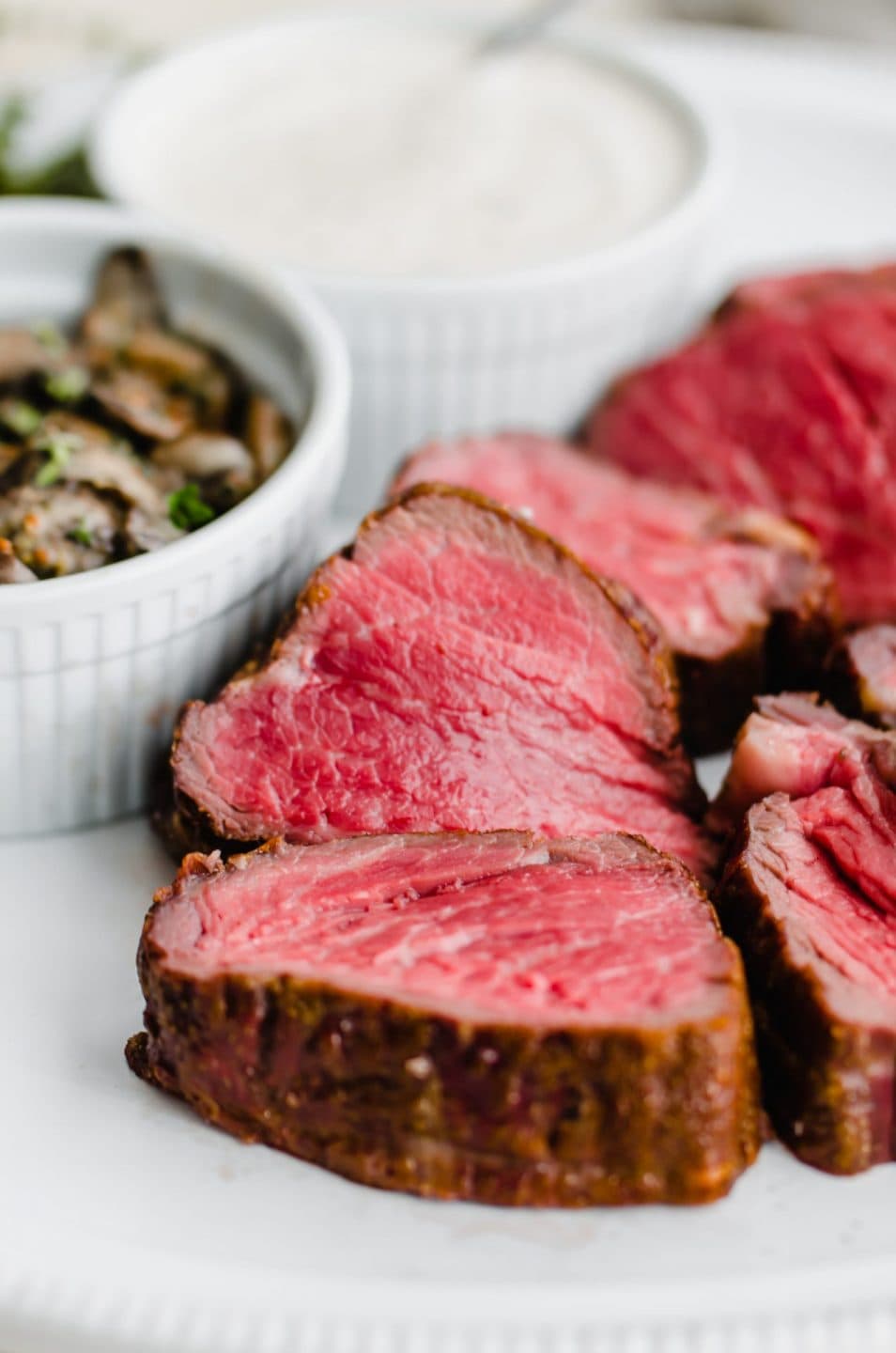
Similar recipes
For another take on tenderloin, see my Beef Tenderloin for Two post!
-
St. Patrick's Day Grazing Board
-
Balsamic Flat Iron Steak Sandwich
-
Beefshi: BLT Roll
-
Shredded Beef and Cheese Taquitos
Are you ready to make some Beef Tenderloin? I'm so excited for you to try this recipe. Once you get the chance to make it, please let me know how it turns out for you!
Leave a comment and rate the recipe below. This will help me with the creation of future recipes!
I'd also love to feature your creation in my weekly newsletter, so you can upload a photo to Instagram with the tag @sweetcayenne5 to be featured! Quick and easy recipe videos are available on my YouTube channel, and lots of menu inspiration on my Pinterest boards. If you haven't seen my Reverse Sear Beef Tenderloin Story, be sure to check that out!
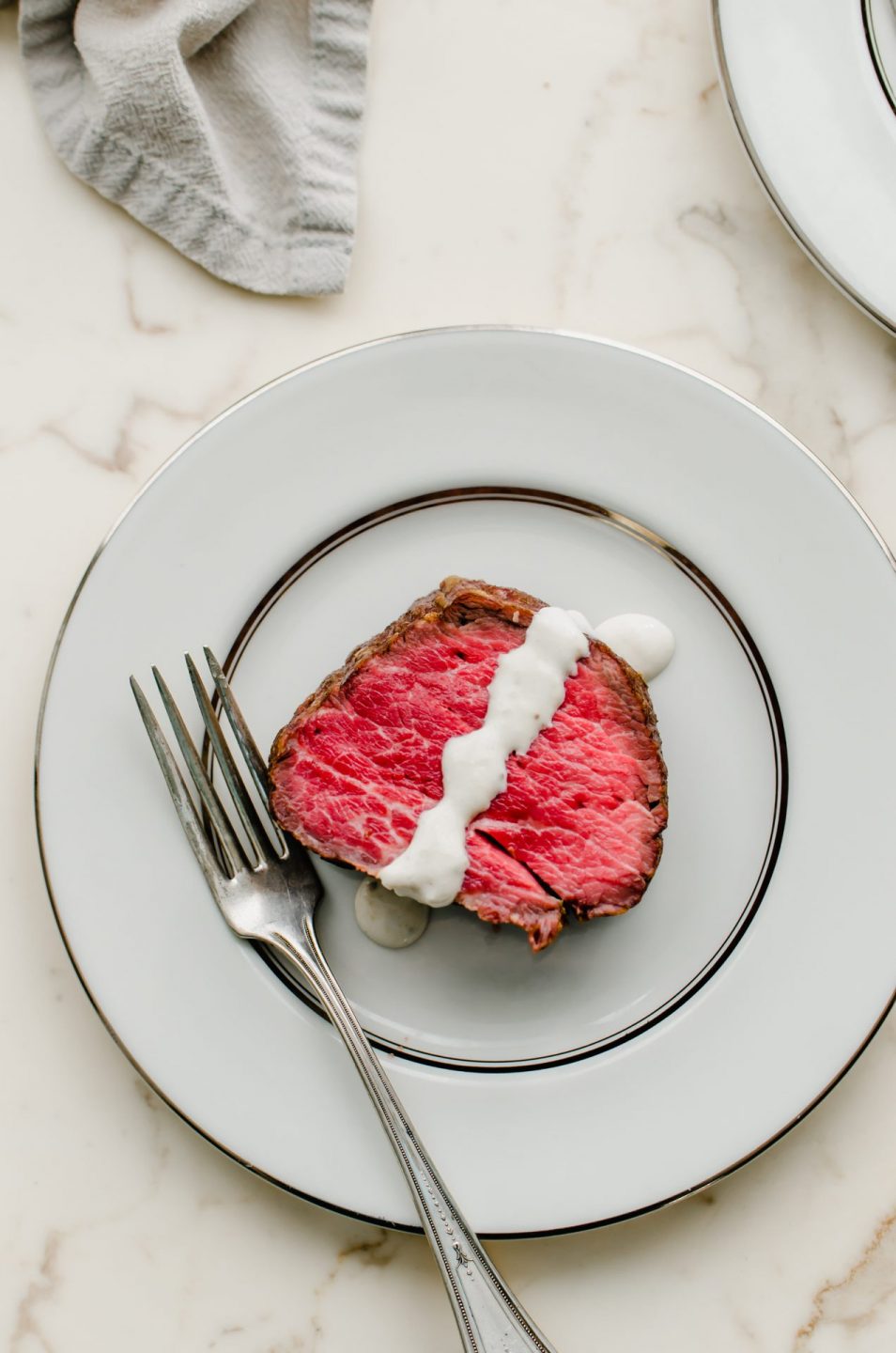
*PLEASE rate and comment on the recipe if you make it! This helps me to continue to bring you recipes like this – THANKS!*
Recipe
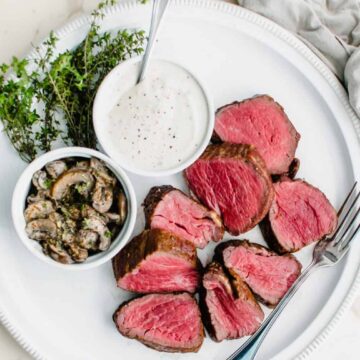
For the beef tenderloin:
- 1 (2-pound) beef tenderloin, trimmed (you can purchase pre-trimmed)
- 1 tablespoon coarse Kosher salt
- 2 tablespoons neutral oil with a high smoke point, such as peanut or canola
- 2 teaspoons butter
For the horseradish cream:
- ½ cup sour cream (I used light)
- 1 tablespoon heavy cream
- 1 tablespoon freshly-squeezed lemon juice
- 2 teaspoons Worcestershire sauce
- 3 tablespoons prepared or freshly grated horseradish, plus more to taste for extra heat
- ¼ teaspoon salt
- ¼ teaspoon freshly-cracked black pepper
For the drunken mushrooms:
- 2 teaspoons butter
- 2 teaspoons olive oil
- 8 ounces cremini mushrooms, stems removed, sliced ¼'' thick
- 1 tablespoon finely chopped shallot
- 2 teaspoons finely chopped fresh thyme
- ⅓ cup marsala wine
- 1 tablespoon whole grain mustard
- 1 tablespoon heavy cream
- Salt and pepper to taste
For the beef tenderloin:
-
Use kitchen twine to tie the tenderloin every 2-3 inches so it has an even thickness throughout the length of the cut of beef. If it has a thinner side on one end, tuck it in and tie it onto the thicker portion of the beef. Place the tenderloin on a wire rack inside of a baking dish. Evenly distribute the salt onto the beef, pressing it into the sides, ends and all around. Place the baking dish into the bottom fridge uncovered (away from other foods), and let the tenderloin rest for 8-24 hours.
-
When ready to cook, remove the tenderloin from the fridge. Preheat the oven to 200℉. Transfer the beef and wire rack onto a baking sheet or roasting pan. Insert a probe from a digital thermometer into the center of one of the ends of the tenderloin, leaving the thermometer portion outside of the oven. Roast the tenderloin until it reaches an internal temperature of 120℉. This will take 1 hour and 30 minutes to 1 hour and 45 minutes for a 2-pound tenderloin.
-
While the tenderloin roasts, make sides and sauces as desired (see below for further instructions).
-
Once the tenderloin reaches 120℉, remove it from the oven. Let it rest for exactly 10 minutes before removing the thermometer. While it rests,place a cast-iron skillet over medium-high heat until it has a surface temperature of 600℉. You'll know it's ready when a drop of water on the surface completely evaporates in 5 seconds. Coat the bottom of the pan with oil, then sear the tenderloin for 45-seconds on each on each of the 4 sides and 30-seconds on the ends. Use a timer - you don't want it to overcook!
-
Remove the tenderloin from the pan and transfer to a cutting board. Coat it with 2 teaspoons of butter, then loosely cover with foil and let it rest for 10 minutes before slicing and serving.
For the horseradish cream:
-
Whisk all ingredients together in a bowl. Cover and refrigerate for at least 30 minutes and up to 1 day before serving to let the flavor develop. Transfer to a serving dish and spoon over tenderloin as desired.
For the drunken mushrooms:
-
Place a large heavy-bottomed skillet over medium heat. Add the butter and olive oil. Once the butter is melted, add the mushrooms in a single layer. Brown the mushrooms for 2-3 minutes on each side. Add the shallots and thyme, stirring for about a minute until fragrant. Add the marsala wine and reduce heat to a simmer. Cook for 4-6 minutes until the wine has cooked down to about 3 tablespoons. Remove from heat and stir in the mustard and cream. Season to taste with salt and pepper. Serve hot over the beef tenderloin.
Serving: 5.3 oz. | Calories: 343 kcal | Protein: 43.8 g | Fat: 17.4 g | Saturated Fat: 6.4 g | Cholesterol: 142 mg | Sodium: 338 mg | Potassium: 540 mg | Calcium: 25 mg | Iron: 3 mg
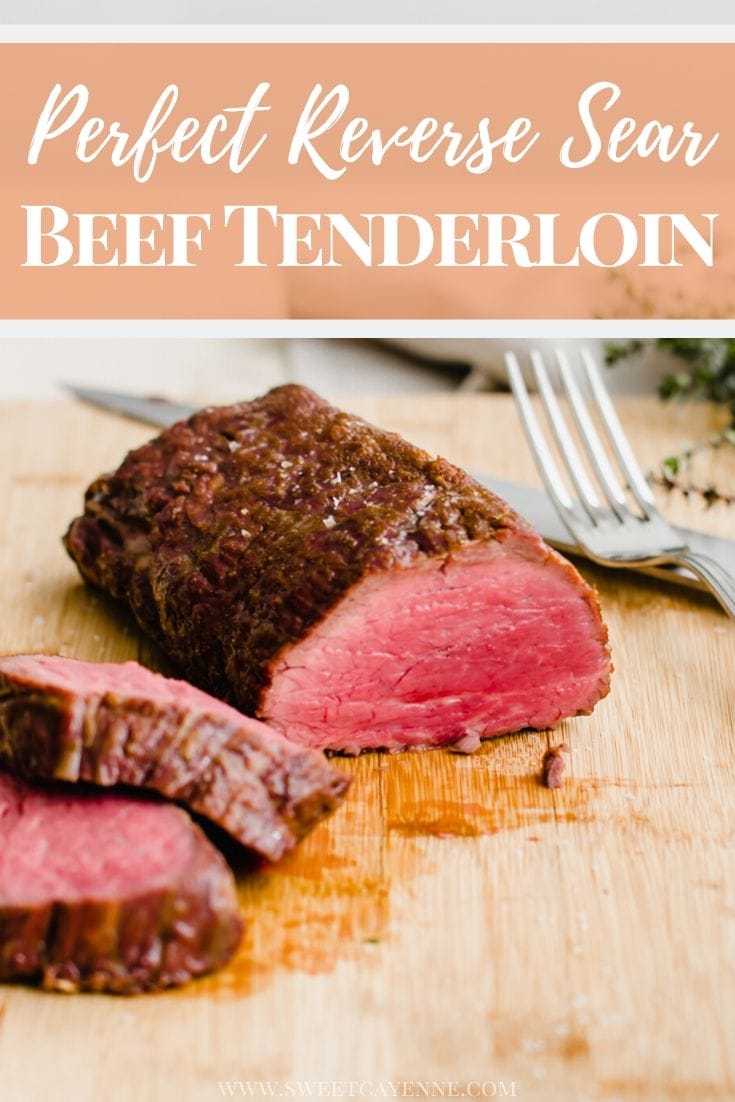
Reader Interactions
Source: https://sweetcayenne.com/reverse-sear-beef-tenderloin/